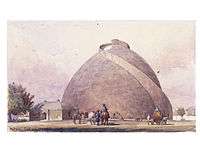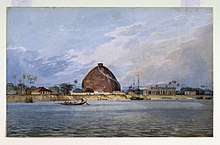Golghar
| Golghar | |
|---|---|
|
Golghar | |
| Former names | The Granary at Patna |
| General information | |
| Architectural style | Stupa |
| Location | Patna, Bihar, India |
| Coordinates | Coordinates: 25°37′13″N 85°08′22″E / 25.6203374°N 85.1394483°E |
| Current tenants | Bihar Government |
| Completed | 20 July 1786 |
| Client | Bihar government |
| Owner | Bihar Government |
| Landlord | Bihar Government |
| Height | 29 m |
| Dimensions | |
| Diameter | 32m-35m.Not sure. |
| Design and construction | |
| Architect | Captain John Garstin |
The Golghar or Gol Ghar (गोलघर), ("Round house") is a large granary located to the west of the Gandhi Maidan in Patna, capital of Bihar state, India.
History
According to a contemporary inscription at its base, the Golghar was intended to be just the first of a series of huge grain stores. In the end, however, no others were ever built. The granary was "part of a general plan … for the perpetual prevention of famine in these provinces"[1] ordered in 1784 by Warren Hastings, the then Governor-General of India.
The beehive-shaped structure was designed by Captain John Garstin of the Bengal Engineers, part of the East India Company's Bengal Army. Its construction completed on 20 July 1786.
A drive to improve the appearance of the structure was begun in 2002.[2]
The architecture
Built in the Stupa architecture, the building has a height of 29 m. It is pillar-less with a wall of thickness of 3.6 m at the base. One can climb at the top of the Golghar through the 145 steps of its spiral stairway around it. The spiral staircase was designed to facilitate the passage of the workers who loaded and unloaded the grain in the granary, who had to carry grain-bags up one flight, deliver their load through a hole at the top, and descend the other stairs.
The top of the Golghar presents a wonderful panoramic view of the city and the Ganges.
Golghar has never been filled to its maximum capacity and there are no plans to do so. Some have claimed that the reason for this is a flaw whereby the doors are designed to open inwards; thus, if it is filled to its maximum capacity, then the doors will not open. However, visitors have found that the doors open outwards.[1] Presently renovation of this historical monument is underway.
Gallery
See also
References
| Wikimedia Commons has media related to Golghar. |
- 1 2 Morris, Jan; Winchester, Simon (2005-01-01). Stones of Empire: The Buildings of the Raj. Oxford University Press. ISBN 9780192805966.
- ↑ Development of Golghar as tourist site in limbo The Times of India, 15 February 2002.
Its goal

